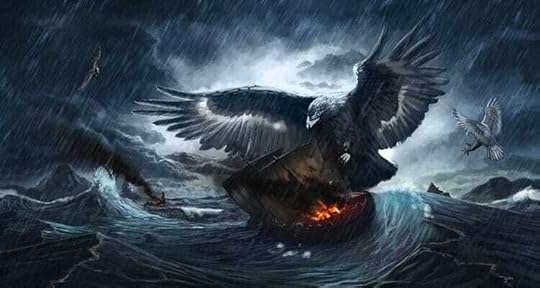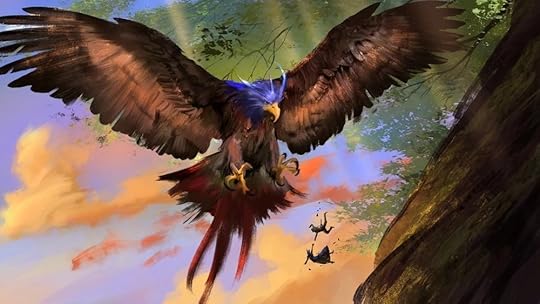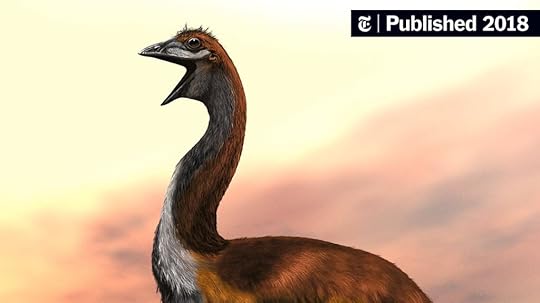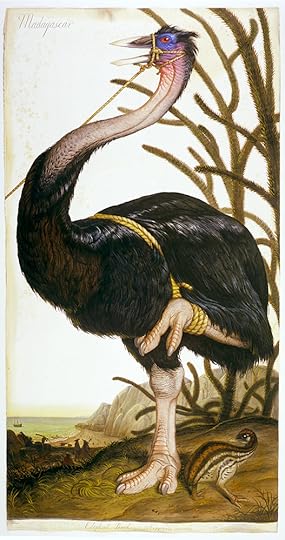The Roc

The roc is an enormous legendary bird of prey from Middle Eastern mythology. It appears in stories such as One Thousand and One Nights and Sinbad. Many stories describe the creature as taking the form of an eagle or condor of stupefying size. They are much larger than typical flying monsters and can take on dragons or carry off elephants.

Stories of the creatures may be able to trace their origins to a fight between the Indian solar bird Garuda and the chthonic serpent Naga. Garuda carried off an elephant at the end of the Sanskrit epics.
Other stories can trace back to the 13 century to the merchant Marco Polo. He described a creature that:
“…was for all the world like an eagle, but one indeed of enormous size; so big in fact that its quills were twelve paces long and thick in proportion. And it is so strong that it will seize an elephant in its talons and carry him high into the air and drop him so that he is smashed to pieces; having so killed him, the bird swoops down on him and eats him at leisure.“
Marco Polo claimed the roc was from Madagascar and made distinctions from a griffin.
So what inspired these gargantuan creatures?

Many historians believe that the origins of the roc are due to sitings of the enormous Aepyornis or the Elephant Bird. These birds once lived in Madagascar, but went extinct, probably as a result of human activity.
These birds could be up to 3 m tall and weigh over 700 kg. Due to their large size, these creatures were flightless and looked much like ostriches or emus. Its eggs are the largest bird eggs to have ever existed, weighing 10 kg – over 150 times the size of a chicken’s egg.
Although these birds went extinct relatively recently, the fossil record for them is patchy, causing much debate about their family tree. Madagascar’s environment is not conducive to fossil preservation and causes skeletons to be fragmented.

Modern technology has helped settle these disputes. Researchers started to examine the abundant eggshells preserved. Compared to other birds, elephant bird eggshell is very thick, trapping DNA inside the layers. The eggshell preserves stable isotope signatures that can be matched to plants and animals of the environment to show how these animals lived.
For example, we know switch grasses are rich in the carbon- 4 isotope. Animals such as gazelles and wildebeest come back with carbon-4 stable isotopes as they primarily eat plants that photosynthesize C4.
Physical characteristics of the eggshell can also reveal information about egg size, bird size, nesting behavior, and can sometimes even distinguish bird groups.

Due to its flightlessness and unusual appearance, this creature was most often mistaken as a chick of a much larger species. This led observers to believe these creatures grew into large birds of prey – later known as the Roc.
Sources:
Alicia Grealy Research Projects Officer. (2023, February 28). Extinct elephant birds were 3 metres tall and weighed 700kg. now, DNA from fossil eggshells reveals how they lived. The Conversation. Retrieved April 4, 2023, from https://theconversation.com/extinct-elephant-birds-were-3-metres-tall-and-weighed-700kg-now-dna-from-fossil-eggshells-reveals-how-they-lived-200628
C3 and C4 photosynthesis. Student Materials. (2018, January 11). Retrieved April 4, 2023, from https://serc.carleton.edu/integrate/teaching_materials/food_supply/student_materials/1167#:~:text=As%20a%20result%20in%20high,sugarcane%2C%20millet%2C%20and%20switchgrass.
Roc Birds. TV Tropes. (n.d.). Retrieved April 4, 2023, from https://tvtropes.org/pmwiki/pmwiki.php/Main/RocBirds
Tyson, Peter (2000). The Eighth Continent. New York. pp. 138–139.
Ubierna, N., Holloway-Phillips, M.-M., & Farquhar, G. D. (2018). Using stable carbon isotopes to study C3 and C4 photosynthesis: Models and calculations. Methods in Molecular Biology, 155–196. https://doi.org/10.1007/978-1-4939-7786-4_10
Uno, K. T., Cerling, T. E., Harris, J. M., Kunimatsu, Y., Leakey, M. G., Nakatsukasa, M., & Nakaya, H. (2011). Late miocene to pliocene carbon isotope record of differential diet change among East African herbivores. Proceedings of the National Academy of Sciences, 108(16), 6509–6514. https://doi.org/10.1073/pnas.1018435108



